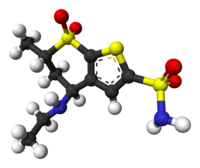 | |
 | |
| Clinical data | |
|---|---|
| Trade names | Trusopt, others |
| AHFS/Drugs.com | Monograph |
| MedlinePlus | a602022 |
| Routes of administration | eye drops |
| ATC code | |
| Legal status | |
| Legal status | |
| Pharmacokinetic data | |
| Protein binding | ~33% |
| Elimination half-life | 4 months |
| Identifiers | |
| |
| CAS Number |
|
| PubChem CID | |
| IUPHAR/BPS | |
| DrugBank | |
| ChemSpider | |
| UNII |
|
| KEGG | |
| ChEBI | |
| ChEMBL | |
| CompTox Dashboard (EPA) | |
| ECHA InfoCard | 100.229.271 |
| Chemical and physical data | |
| Formula | C10H16N2O4S3 |
| Molar mass | 324.43 g·mol−1 |
| 3D model (JSmol) | |
| |
| |
| | |
Dorzolamide, sold under the brand name Trusopt among others, is a medication used to treat high pressure inside the eye, including in cases of glaucoma.[3] It is used as an eye drop.[3] Effects begin within three hours and last for at least eight hours.[3] It is also available as the combination dorzolamide/timolol.[3][4]
Common side effects include eye discomfort, eye redness, taste changes, and blurry vision.[3] Serious side effects include Steven Johnson syndrome.[3] Those allergic to sulfonamides may be allergic to dorzolamide.[3][5] Use is not recommended in pregnancy or breastfeeding.[5] It is a carbonic anhydrase inhibitor and works by decreasing the production of aqueous humor.[3]
Dorzolamide was approved for medical use in the United States in 1994.[3] It is available as a generic medication.[5] In 2022, it was the 201st most commonly prescribed medication in the United States, with more than 2 million prescriptions.[6][7]
- ^ "Prescription medicines: registration of new generic medicines and biosimilar medicines, 2017". Therapeutic Goods Administration (TGA). 21 June 2022. Retrieved 30 March 2024.
- ^ "Product monograph brand safety updates". Health Canada. February 2024. Retrieved 24 March 2024.
- ^ a b c d e f g h i "Dorzolamide Hydrochloride Monograph for Professionals". Drugs.com. American Society of Health-System Pharmacists. Retrieved 26 March 2019.
- ^ "Dorzolamide (Ophthalmic Route) Description and Brand Names". Mayo Clinic. Retrieved 3 November 2023.
- ^ a b c British national formulary : BNF 76 (76 ed.). Pharmaceutical Press. 2018. p. 1148. ISBN 9780857113382.
- ^ "The Top 300 of 2022". ClinCalc. Archived from the original on 30 August 2024. Retrieved 30 August 2024.
- ^ "Dorzolamide Drug Usage Statistics, United States, 2013 - 2022". ClinCalc. Retrieved 30 August 2024.